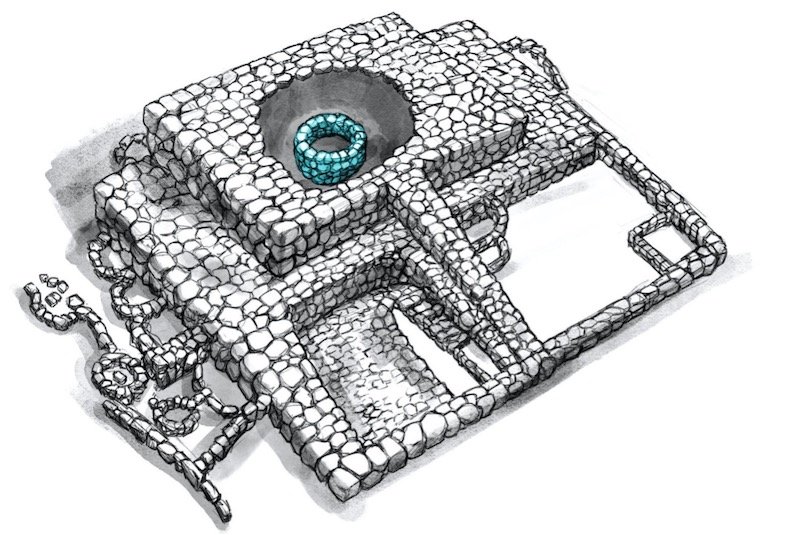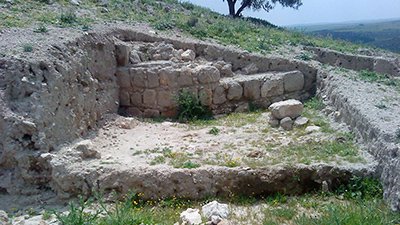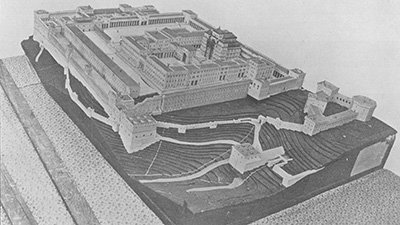Joshua’s Altar and the Mount Ebal Curse Tablet
An archaeological find confirms biblical history.
Critical scholars often view the historical accounts in the Old Testament as fiction or mythology. But what happens when archaeology confirms what we read in the Old Testament? Recent archaeological discoveries at Mount Ebal strongly confirm a historical event in the Old Testament.
Has Joshua’s Altar Been Found?
In Deuteronomy 27, before Israel had crossed the Jordan to take possession of the land of Canaan, Moses charged them that when they entered Canaan, six tribes (Simeon, Levi, Judah, Issachar, Joseph, and Benjamin) should stand on Mount Gerizim to read and recite the blessings that would come to them if they kept God’s law. The other six tribes (Reuben, Gad, Asher, Zebulun, Dan, and Naphtali) were to stand on Mount Ebal and read and recite the curses that would come upon them if they disobeyed God’s law.
In Joshua 8, after the Israelites had their victory at the Canaanite fortress (or city) of Ai, they held a covenantal ceremony with the Lord (YHWH, יהוה) near Shechem, with Mount Gerizim on one side and Mount Ebal on the other (Joshua 8:33). It was on Mount Ebal where Joshua built an altar to the Lord (Joshua 8:30). Mount Ebal is located northwest of the Dead Sea and about 30 miles north of Jerusalem in the west bank of Israel. South of Mount Ebal is Mount Gerizim, and between them is the city of Shechem (Joshua 24:25).1 To the north of Shechem, Mount Ebal rises 3,084 feet above sea level, and located on the eastern side of the mountain is an altar that was discovered by secular Israeli archaeologist Professor Adam Zertal (1936–2015) on behalf of the University of Haifa.2
In 1980, Professor Zertal discovered a large rectangular altar (30 meters square and 3 meters high, see below) on Mount Ebal, and from 1982–1989, excavation followed. Zertal believed the large rectangular structure was Joshua’s covenant ceremony altar (Joshua 8:30–35). Zertal’s discovery was initially met with skepticism by many in the archaeological community, but several respected archaeologists (e.g., Professor Benjamin Mazar, Hebrew University) were convinced. The excavations around the large structure revealed large amounts of ash and over 1000 bones from young, choice male animals (mainly kosher). This indicated the site was used for animal sacrifices conducted according to biblical standards. Based on the pottery and scarabs found, Zertal dated the altar from the thirteenth to twelfth centuries (c. 1225 BC).3 If this is Joshua’s altar, then it presents a problem for the exodus and conquest of Canaan taking place in the fifteenth century BC (1446–1400 BC). However, Zertal’s excavations also document the presence of an earlier altar underneath the massive rectangular altar (see below).4 The earlier altar was circular, had a diameter of only 2 meters, and was made from unworked, medium-size stones. Zertal noted that immediately on top of this smaller altar was a ten-centimeter layer of clean ash and animal bones, most of which were burnt (cf. Deuteronomy 27:7; Joshua 8:31). Zertal believed the smaller round altar was built before the larger rectangular one, but he dated it to around the same period (c. 1250 BC).
Several years ago, archaeologist Dr. Scott Stripling turned his attention to Zertal’s discoveries at Mount Ebal. Due to political reasons, however, Dr. Stripling was unable to continue Zertal’s excavations on Mount Ebal, but he was able to wet-sift the material excavated by Zertal that was left in dump piles next to the large structure. Dr. Stripling agrees that the smaller circular altar was built before the larger rectangular altar. However, Dr. Stripling not only believes that Zertal’s altar has been misdated, but that the round altar is most likely Joshua’s altar and should be dated to the fifteenth century BC (c. 1400 BC).5 Dr. Stripling supports this interpretation from evidence discovered from the wet-sifting of Zertal’s excavated material. Dr. Stripling found pottery from an earlier period in the fill, suggesting an earlier use of the site.
The round altar at Mount Ebal could very well be Joshua’s altar and is consistent with a fifteenth-century exodus and the conquest of Canaan under Joshua.
In the material associated with the round altar, a scarab belonging to Pharaoh Thutmose III (c.1504–1450 BC) was found. The traditional view is that the Thutmose III scarab is commemorative and belongs to the thirteenth century. Dr. Stripling, however, argues, “This is nothing new. The identification of Eighteenth Dynasty [fifteenth century] scarabs from sites like Mount Ebal, Shiloh, and Jericho are often judged to be commemorative because they challenged the dominant late-date theory. The theory now drives the interpretation.”6 If the Thutmose III scarab is not commemorative, as Stripling believes, then it provides evidence for the earlier construction of the smaller circular altar. The round altar cannot be an earlier Canaanite altar as Joshua was commanded to tear down their altars (Judges 2:2; cf. Exodus 34:13). Furthermore, all the stones belonging to the round altar are unworked, which fits with the requirement of Joshua 8:31. The round altar at Mount Ebal could very well be Joshua’s altar and is consistent with a fifteenth-century exodus and the conquest of Canaan under Joshua.

Joshua’s altar on Mount Ebal. Image courtesy of Melissa Barreiro/Armstrong Institute of Biblical Archaeology
A Curse Tablet on Mount Ebal
In 2022, a research team led by Dr. Stripling from the Associates for Biblical Research (ABR) revealed the discovery of a lead tablet (2 cm by 2 cm) from Mount Ebal that they claim contains the oldest extant Hebrew inscription.7 The tablet was found in 2019 through a project to wet-sift the east dump piles from Zertal’s excavation at Mount Ebal. The archaeological context and epigraphical analysis indicate that the curse tablet (Defixio) is believed to date to the Late Bronze Age II period (c. 1400–1200 BC).8 This is at least two centuries older than any known Hebrew inscription from ancient Israel.9 The folded lead tablet contains an ancient Hebrew inscription which was inscribed on the lead with an iron stylus (cf. Job 19:23–24) in proto-alphabetic script (or proto-Hebrew script) and consists of 48 letters (one is a form of the divine name YHW (YHWH) in conjunction with another Hebrew name for God, El).10 The inscription is a chiastic parallelism and reads,
You are cursed by the god yhw, cursed.
You will die, cursed—cursed, you will surely die.
Cursed you are by yhw—cursed.11

Mount Ebal Curse Tablet. Image courtesy of Associates for Biblical Research
This discovery confirms that the Hebrews worshipped one God but had different names for him (Deuteronomy 4:35, 6:4, 10:17).
The use of the two Hebrew names together (YHW and El) to refer to the same God refutes a major element of the liberal documentary hypothesis. Critical scholars believe that the Torah was not written by Moses in the fifteenth century BC but was compiled in different periods (c. 960–550 BC) by many authors (abbreviated as J, E, D, and P), who worshipped different gods, YHWH and El/Elohim. This discovery confirms that the Hebrews worshipped one God but had different names for him (Deuteronomy 4:35, 6:4, 10:17). It also confirms that the Hebrews were literate (Deuteronomy 6:9).
The location and date correspond perfectly to what Scripture states in Deuteronomy 11:29, “And when the Lord your God brings you into the land that you are entering to take possession of it, you shall set the blessing on Mount Gerizim and the curse on Mount Ebal.” According to Deuteronomy 27 and Joshua 8, Mount Ebal was the mountain of the curse (see above).12 If the tablet dates to around 1400 BC, then this would correspond to the conquest of Canaan under Joshua and firmly root the exodus some 46 years before (40 years in the wilderness + around 6 years for the conquest of Canaan), right in the range of 1446 BC, the biblical date of the exodus (see 1 Kings 6:1).
At Mount Ebal, Joshua wrote on stones a copy of the law of Moses (Joshua 8:32). This foreshadowing event helps us understand our own reality. In Galatians 3:10, the Apostle Paul writes, “For all who rely on works of the law are under a curse; for it is written, ‘Cursed be everyone who does not abide by all things written in the Book of the Law, and do them.’” As descendants of Adam, mankind is under the curse of the law and that curse needs to be removed. Paul goes on to say in Galatians 3:13, “Christ redeemed us from the curse of the law by becoming a curse for us—for it is written, ‘Cursed is everyone who is hanged on a tree.’” For all those who trust in Christ, his death on the cross has removed the curse of sin. Jesus came from heaven, the place of blessing, to earth, the place God cursed (Genesis 3:17), to offer himself as a sacrifice for the forgiveness of sins so that we would not receive the curse that we do deserve but would receive the blessings that we do not deserve (Ephesians 1:3).
Footnotes
- Shechem is where Abraham first sacrificed to God when he entered Canaan around 600 years earlier (Genesis 12:6–7).
- The altar is oriented toward the east (a ramp was uncovered on the western side of the altar). If a priest was ascending the altar on the ramp to offer sacrifices, then he would be facing east (cf. Exodus 27:13).
- Adam Zertal, “Has Joshua’s Altar Been Found on Mt. Ebal?” BAR 11, no. 1 (1985): 26–43.
- Adam Zertal, “An Early Iron Age Cultic Site on Mount Ebal: Excavation Seasons 1982–1987,” Tel Aviv 14 (1987): 110.
- Scott Stripling, “The Fifteenth-Century (Early Date) Exodus View,” in Five Views On the Exodus, ed. Mark D. Janzen (Grand Rapids, Michigan: Zondervan, 2021), 47.
- Stripling, “The Fifteenth-Century (Early Date) Exodus View,” 47–48.
- The findings have been peer-reviewed. See Dr. Scott Stripling et al., “‘You are Cursed by the God YHW:’ an early Hebrew inscription from Mt. Ebal,” Heritage Science 11, no. 105 (May 2023): https://heritagesciencejournal.springeropen.com/articles/10.1186/s40494-023-00920-9.
- There are only two choices for dates for contents from the dump piles from Mount Ebal: Late Bronze Age II (1400–1200 BC) or Iron Age I (1200–1100 BC).
- It would predate the Khirbet Qeiyafa ostracon (tenth century BC) by at least two centuries.
- The inside of the curse tablet contains 48 “proto-alphabetic” letters, 9 of which are aleph (the first letter of the Hebrew alphabet). In the 23-word English translation of the inscription, the word curse (’arur) appears six times and the sacred name, YHW, appears twice.
- A tomographic scanner from the Institute of Theoretical and Applied Mechanics in Telč (Czech Republic) was used to find the reading on the inside of the lead tablet. On the tablet, there was an image of an “Ox-Head,” the symbol which later developed into the first letter of the Hebrew alphabet, aleph. This symbol was part of the “proto-alphabetic” script and was used prior to 1200 BC. Some of the earliest known “proto-alphabetic” texts were discovered near turquoise mines in the Sinai Peninsula. These are similar to the text in the Mount Ebal curse tablet.
- It is possible that the Mount Ebal curse tablet reflects a verdict against an individual sinner under a divine curse (see Deuteronomy 21:22–23).

Answers in Genesis is an apologetics ministry, dedicated to helping Christians defend their faith and proclaim the good news of Jesus Christ.
- Customer Service 800.778.3390
- © 2024 Answers in Genesis



